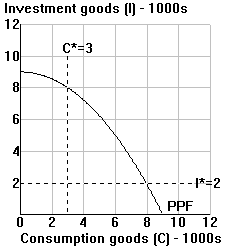| THE PRODUCTION POSSIBILITIES
FRONTIER |
|
|
6. |
Consider the following information
about an economy's production possibilities for "pleasures of the flesh" and
"pleasures of the spirit": |
|
| Flesh |
0 |
1 |
2 |
3 |
4 |
5 |
| Spirit |
44 |
42 |
36 |
26 |
14 |
0 |
|
|
a. |
Graph the economy's production
possibilities frontier (PPF), putting Flesh on the horizontal axis and Spirit on the
vertical axis. |
|
b. |
Use "///" to shade
currently unattainable production points and "\\\" to shade production points
which are attainable but associated with inefficiency and/or unemployment. |
|
c. |
What is the (marginal) opportunity cost of the
third unit of Flesh? The fourth unit? |
|
d. |
Depict the possible consequences of
each of the following in your PPF diagram (consider each event separately, and be keep in
mind that some events shift the PPF while others only keep an economy from reaching its
PPF): |
|
|
(1) |
A severe economic recession temporarily raises
the unemployment rate. |
|
|
(2) |
A technological breakthrough increases the
productivity of resources in the Spirit industry by 50 percent. |
|
|
(3) |
Discrimination by some employers results in
inefficient production because some "less qualified" individuals end up employed
in the Flesh industry when "more qualified" workers are available. |
|
|
|
